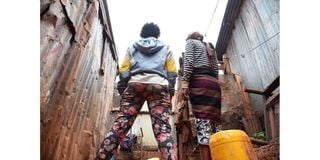Uncertainty, stigma and struggle: The case for female derelicts

GBV survivors in Kangemi, Nairobi, on October 18, 2022. They separated from their husbands following frequent abuse and no live on the streets.
What you need to know:
- Most of them do not have enough money to pay to use public toilets.
- They bathe in the open, which exposes them to sexual violence.
- To survive on the unsafe streets, the women had to enlist men for protection.
Street persons are homeless. And homelessness manifests itself in five forms, explains Dr Suzanne Speak in an undated paper, Affordable housing and social protection systems for all to address homelessness, on the state of homelessness in developing countries.
The five are rough sleeping, pavement dwelling, squatting, living abjectly poor and living in refugee camps. Rough sleepers are those who spend a night on the street, under a bridge or in public places such as under the bridge along Nairobi River, or at the foot of the pillars of Nairobi Expressway.
In a recent report on period poverty among Nairobi Street women, Nation.africa highlighted the women’s plight in menstrual health management. In the story, two young women revealed that they had resorted to crude methods, including using a carrier-bag, popularly known as ‘Uhuru bag’ in Kenya, to fashion tampons.
Menstrual health management is, however, just the tip of the iceberg of these women’s multiple challenges.
From physical to sexual assault or being forced to exchange sex for money or food, mental illness, and lack of hygienic menstrual products, their problems are endless.
Most vulnerable to death and malnutrition are the pregnant ones and those with children, considering their additional needs for balanced nutrient intake and ante and post-natal health checks, something they go without.
Risk of infection
Then again, due to their vulnerability to sexual assault and commercial sex work, they are more likely to be infected with sexually transmitted diseases.
In 2005, Jasinski Jana et al., conducted a study on the experience of violence among homeless women. They sampled 737 women and 91 men, all homeless, in Florida, US. They established that 78.3 per cent of the women had been subjected to rape, physical assault and stalking compared to 14.3 per cent of men.
The Ministry of Labour and Social Protection found that 46,639 people live on the streets across Kenya’s 47 counties as per a 2018 National Census of Street Families.
Although the study didn’t explore exposure of the street persons to sexual assault, it established that 96.1 per cent of women engaged in sex work at night. In the same line, 70 per cent of the women didn’t use a condom compared to 59 per cent of the men.
And 55 per cent of the women were infected with HIV or suffered from sexually transmitted diseases. Media reports further say street women exchange sex for as little as Sh100 to afford basic needs.
As a result of all these problems, up to 75 per cent of these women suffer from mental illnesses according to Homeless Hub, an online portal on homelessness curated by Canadian Observatory on Homelessness.
Similarly, a study conducted by the African Journal of Midwifery and Women’s Health on Street women in Kenya, highlighted a myriad of other difficulties the women experience. It says sexual violence is rampant.
Furthermore, most of the sexually abused women did not report the abuse or seek treatment because they felt that authorities would condemn them rather than offer care.
Additionally, the study says girls living on the streets were forced to have early sex, leading to unwanted and teenage pregnancies.
To survive on the unsafe streets, the women had to enlist men for protection.
“Men and other women living on the streets tell the women that to live on the streets, they will need to have a man to take care of them. The participants in some occasions got involved unknowingly with robbers. This put them at risk of being associates when their partners were caught and killed,’’ part of the report reads.
Another study by the University of Ghana on homelessness amongst women in Accra, Ghana found that 96 per cent of women living on the streets could not access clean water and sanitation facilities.
Most of them did not have enough money to pay to use public toilets. They, therefore, bathed in the open, which exposed them to sexual violence.





